Crew 14 Date 19 August 1980 Fatalities 301 (all) Passenger count 287 | Passengers 287 Survivors 0 Survivor 0 Location Riyadh | |
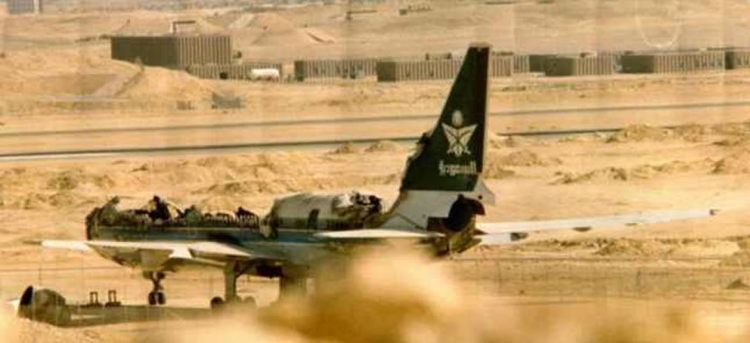 | ||
Summary In-flight fire in cargo hold, pilot error Similar Charkhi Dadri mid‑air co, Turkish Airlines Flight 981, American Airlines Flight 191, Air India Flight 182, Iran Air Flight 655 | ||
Fs2004 deadly delay saudia flight 163
Saudia Flight 163 was a scheduled passenger flight of Saudia that caught fire after takeoff from Riyadh International Airport (now the Riyadh Air Base) on a flight to Jeddah, Saudi Arabia on Tuesday, 19 August 1980. All 287 passengers and 14 crew on board the Lockheed L-1011-200 TriStar, registration HZ-AHK, died after the aircraft made an emergency landing back at the Riyadh airport.
Contents
- Fs2004 deadly delay saudia flight 163
- Passengers and crew
- Fire
- Investigation
- Lawsuit
- Policy changes
- Dramatization
- References
At the time, the accident was the second deadliest single aircraft disaster in history, after Turkish Airlines Flight 981. It's the sixth deadliest aircraft disaster overall, after the Tenerife airport disaster, Japan Airlines Flight 123, the Charkhi Dadri mid-air collision, Turkish Airlines Flight 981, and Air India Flight 182. It was also the highest death toll of any aviation accident in Saudi Arabia and the highest death toll of any accident involving a Lockheed L-1011 TriStar anywhere in the world. It is also the deadliest aviation disaster that did not involve a crash on impact or mid-flight break up.
Passengers and crew

Saudi officials said that most of the passengers were Saudis or Pakistanis, with many of the passengers being Pakistani religious pilgrims. The aviation directorate stated that 82 of the passengers boarded in Karachi and, of the passengers who boarded in Riyadh, 32 were religious pilgrims from Iran. Diplomats in Jeddah said that in addition to the Iranian, Saudi and Pakistani passengers, there were four Koreans, three Britons, two Thais, one Finn, one French, one Spanish, one Italian, one Chinese, one German, one Canadian, one Taiwanese, one Irishman, one Dutchman, two Americans and one Japanese on board the flight. The crew included six Filipinos, three Pakistanis, and one Briton. Both the captain, 38-year-old Mohammed Ali Khowyter, and the co-pilot, 26-year-old Sami Abdullah M. Hasanain, were Saudi nationals. The flight engineer was 42-year-old Bradley Curtis.
Fire
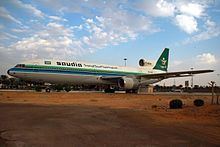
Flight 163 took off at 18:08 GMT to complete its final leg to Jeddah. Almost seven minutes into the flight the crew received warnings of smoke from the aft cargo compartment. The next four minutes were spent by the crew trying to confirm the warnings, and by the flight engineer going back into the cabin to confirm the presence of smoke in the cabin. The captain decided to return to the airport. The thrust lever for the number 2 engine (center engine) later became stuck as the fire burned through the operating cable, and the engine was shut down on final approach.
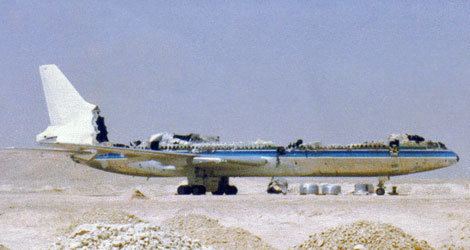
The captain declared an emergency and returned to Riyadh International Airport and landed safely. After touchdown, contrary to the captain's declaration of an emergency landing, the airplane continued to a taxiway at the end of the runway and exited the runway, stopping on the taxiway 2 minutes 40 seconds after touchdown. The airport fire rescue equipment were stationed at the landing section of the runway expecting an emergency stop and evacuation. Why the captain did not immediately order an emergency evacuation of the aircraft is unknown. Because the fire rescue equipment was farther down the runway it took extra time to arrive at the aircraft, which had used the entire length of a 4,000-metre (13,000 ft) runway to slow and exit onto a taxiway. The aircraft stopped on the taxiway facing the opposite direction from landing. On arrival at the aircraft the rescue personnel did not immediately attempt to open any of the aircraft doors as the engines on the wings were still running. These two engines were shut down three minutes and 15 seconds after the aircraft came to a stop. There was no external fire visible at this time, but flames were observed through the windows at the rear of the aircraft. Twenty-three minutes after engine shut down, the R2 door (second door on the right side) was opened by ground personnel. Three minutes later, the aircraft burst into flames, and was consumed by fire. Autopsies were conducted on some of the non-Saudi nationals including the American flight engineer. All perished from smoke inhalation and not burns, which indicated that they had died long before the R2 door was opened.

One final transmission was received after the plane stopped, indicating that the emergency evacuation was about to begin. All of the victims were found in the forward half of the fuselage.
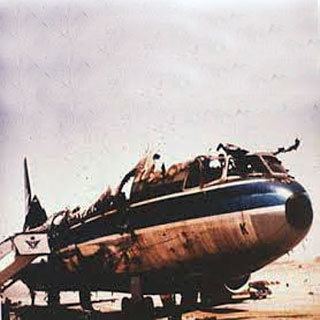
It took 23 minutes from the engine shutdown until the fuselage was accessed. Saudi reports stated that the crew could not get the plug-type doors to open in time. It is assumed that most passengers and flight attendants were incapacitated during the landing roll or they would not have attempted to open a door on a moving aircraft. It is known that the aircraft remained pressurized during the landing roll as the cabin pressurization system was on standby and the aircraft was found with both pressurization doors almost completely closed. These pressurization doors should have opened completely on touchdown to depressurize the aircraft. The crew were found still in their flight station seats. The source of the fire in compartment C3 is unknown.
Investigation
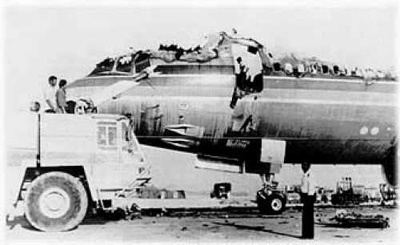
The investigation revealed the fire had started in the aft C3 cargo compartment. The fire was intense enough to burn through the cabin floor, causing passengers seated in that area of the cabin to move further forward in the cabin prior to the emergency landing. Saudi officials subsequently found two butane stoves in the burned-out remains of the airliner, with a used fire extinguisher near one of them.
One early speculation about the cause of the fire was that the fire originated in the passenger cabin when a passenger used his own butane stove to heat water for making tea. However, that early speculation was rejected by the findings in the official accident report.
Lawsuit
Walter Muller, a former chief of the Policy Analysis Division of the Federal Aviation Administration, filed a lawsuit against Lockheed, Saudia, and Trans World Airlines, an American airline that trained Saudi pilots and supervised the Saudi maintenance program. Muller's brother, Jack A. Muller, and his sister in law, Elizabeth S. Muller, died in the fire. Muller's suit stated that Lockheed allowed for "dangerous materials to be incorporated in the fuselage," that there was no vent system to distribute the gases away from the passengers, and that a sufficient oxygen system did not exist. Muller's suit accused Saudia of not properly maintaining the aircraft and providing safety for passengers and accused TWA of not properly maintaining the Saudia aircraft and not properly training crew.
Policy changes
After the event, the airline revised its training and emergency procedures. Lockheed also removed the insulation from above the rear cargo area, and added glass laminate structural reinforcement.
The National Transportation Safety Board recommended that aircraft use halomethane extinguishers instead of traditional hand-held fire extinguishers.
Dramatization
In 1982 the television series World in Action aired an episode entitled "The Mystery of Flight 163" which documented the accident and was subsequently used to train pilots in the value of Crew resource management.
